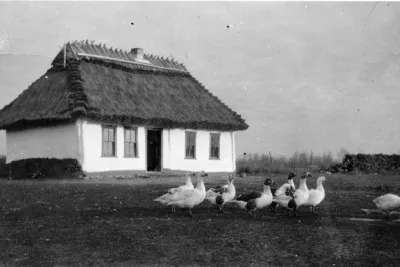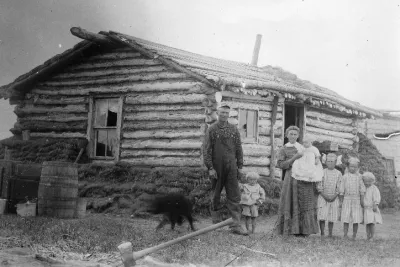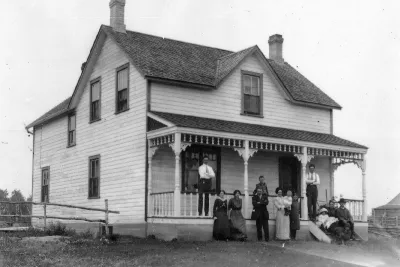Grade 4: Homes and Historical Thinking
Look at these pictures of homes in Saskatchewan...
- What details do you notice?
- From what materials is each home made?
- What can you guess about the environment that was near each home?
- What does the home and surrounding environment tell you about the people who live there?

Woman sitting outside a tipi, n.d.
PAS Photo R-A7672.
Historical Homes in Saskatchewan

Woman sitting outside a tipi, n.d.
PAS Photo R-A7672.

Flock of geese in front of a typical Ukrainian-style house with white-washed walls and thatched roof. PAS Photo R-A269.

Family standing outside a log house banked up with sod, ca. 1903. PAS Photo R-A7227.

Tom Maloney's timber-frame house in the Burroughs district, ca. 1916. PAS Photo R-A6218.

"No Place LIke Home." Rudolf Einhardt's sod house 2 miles south-east of Glamis, SK, n.d, PAS Photo S-B430

W.R. Motherwell's stone house near Abernethy, SK. The house was built in 1897; the picture was taken in 1965. PAS Photo R-A7194-1.
Curriculum & Historical Thinking Connections
CURRICULUM: Saskatchewan Grade 4 Social Studies Outcome Focus: DR4.1
Correlate the impact of the land on the lifestyles and settlement patterns of the people of Saskatchewan.
Ex. Identify the impact of geography on the architecture of Saskatchewan, including how styles, materials, and cultural traditions have been affected by interaction with the land and other people in the province.
Historical Thinking Concepts
Evidence – How do we know what we know about the past?
Guidepost 1: History is interpretation based on inferences made from primary sources. Primary sources can be accounts but they can also be traces, relics or records.
Cause and Consequence – Why do events happen and what are their impacts?
Guidepost 3: Events result from the interplay of two types of factors: 1. historical actors who are people (individuals or groups) who take actions that cause historical events and 2. the social, political, economic, environmental and cultural conditions within which the actors operate.